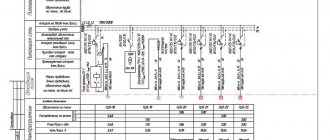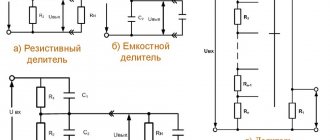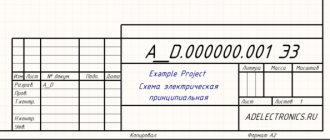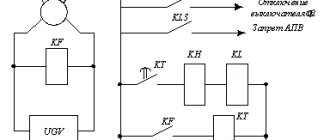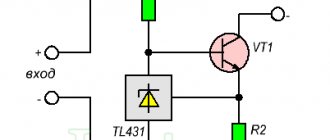Voltage class
Voltage class
is a typical value of linear (phase-to-phase) voltage in electrical networks, which is nominal for various groups of equipment: transformers, lines, generators, reactors and others. The voltage class determines the required level of electrical insulation of electrical equipment. The order of the voltage class determines for what purposes and tasks this equipment is used. In particular, low voltages are used to distribute power between small consumers over short distances, medium classes - to distribute power between average consumers and groups of consumers over moderate distances, high and ultra-high classes - to distribute power between large consumers and to transmit power over long distances. . In other words, low and medium voltage classes are typical for distribution networks, while high and ultra-high classes are for backbone networks connecting individual power systems.
How to try on two regulatory documents?
Despite the inconsistencies described above, both standards allow a possible deviation of characteristics from the nominal value by 10%, both up and down. However, note that the 220 V rating will allow a voltage deviation ranging from 198 V to 242 V. At the same time, the new 230 V rating will have a variation of 207 V to 253 V between the possible minimum and maximum in the outlet.
To even out the discrepancy between different standards, GOST 29322-2014 provides the following voltage options for 230 V networks in Table A.1:
- nominal – 230 V:
- the highest used for power supply is 253 V;
- the smallest for power supply is 207 V;
- the smallest used is 198 V.
The need to use different voltage classes
In the early days of the electric power industry, when the idea of interconnected power systems had not yet arisen, electrical networks were used in isolation at individual enterprises, similar to how mechanical transmission systems were used before. Each of the enterprises sought to build their own station and manage it independently. The idea of a power plant, as an independent facility aimed exclusively at generating and selling electricity as a commodity, was one of the first to be proposed by Samuel Insull [1]. And if previously low voltage classes, which could be different, were sufficient for the needs of industry, since there was no task of joint work of enterprises, now in the new realities two key questions arose: how to transfer power from power plants to several consumers at once - the problem of remoteness of electricity sources from consumption areas, and how to ensure voltage compatibility of all installations used?
If the second issue was resolved relatively simply from the point of view of the electric power industry: a standard for voltage classes was introduced, which ensured their compatibility, then the first of them turns out to be, on the contrary, extremely complex, since long-distance transmission creates several engineering problems at once. Below are the main ones:
The higher the voltage, the less power loss
. This pattern is well described by the formula for losses in a network element based on the transmission end parameters:
where is power loss in transmission, MVA; , — power at the end of transmission, MW and MVar; — voltage module at the end of transmission, kV; , — active and reactive transmission resistance, Ohm. This formula clearly shows that when transmitting one power, with increasing voltage, power losses decrease quadratically.
The higher the voltage, the higher the limit of transmitted power
. For any transmission, there is a limit on the transmitted active power, determined by static stability, which in the simplest case, based on the equation of the angular characteristics of the transmission, is determined by the following expression:
where is the voltage at the ends of the transmission, kV; — transmission reactance, Ohm; — limit of transmitted power, MW. It is easy to see that with increasing voltage the limit of transmitted power increases quadratically.
The most rational voltage class from the point of view of minimum losses and capital investments is determined at the stage of long-term planning of operating modes of the electrical network.
Voltage class classification
According to the voltage level, all voltage classes are conventionally divided into the following groups:
- Ultra-high voltage class - from 1000 kV.
- Ultra-high voltage class - from 330 kV to 750 kV.
- High voltage class - from 110 kV to 220 kV.
- Average voltage class - from 1 kV to 35 kV.
- The lowest voltage class is up to 1 kV.
The maximum permissible operating voltages exceed the rated values by 15%, 10% and 5%. The rated voltage scales of generators and secondary windings of transformers are chosen to be 5-10% higher than the rated voltages of consumers, power lines, and primary windings of transformers in order to make it easier to maintain the rated voltage of consumers.
| Voltage classes | ||||||||||||||||||
| Voltage class, kV | 0,22 | 0,38 | 0,66 | 3 | 6 | 10 | 13,8 | 15,75 | 18 | 20 | 35 | 110 | 150 | 220 | 330 | 500 | 750 | 1150 |
| Maximum permissible operating voltage, kV | 0,253 | 0,437 | 0,759 | 3,6 | 6,9 | 11,5 | 15,87 | 18,11 | 20,7 | 23 | 40,5 | 126 | 172 | 252 | 363 | 525 | 787 | 1207,5 |
| Electrical networks, kV | 0,22 | 0,38 | 0,66 | 3 | 6 | 10 | — | — | — | 20 | 35 | 110 | 150 | 220 | 330 | 500 | 750 | 1150 |
| Generator, kV | 0,23 | 0,4 | 0,69 | 3,15 | 6,3 | 10,5 | 13,8 | 15,75 | 18 | 20 | — | — | — | — | — | — | — | — |
| Transformer primary winding, kV | 0,22 | 0,38 | 0,66 | 3; 3,15 | 6; 6,3 | 10; 10,5 | 13,8 | 15,75 | 18 | 20 | 35 | 110; 115 | 150; 158 | 230 | 330 | 500 | 750 | 1150 |
| Transformer secondary winding, kV | 0,23 | 0,4 | 0,69 | 3,15; 3,3 | 6,3; 6,6 | 10,5; 11 | — | — | — | 22 | 36,75; 38,5 | 115; 121 | 158; 165 | 242 | 347 | 525 | 787 | — |
Meanwhile in Russia
Russia was lagging behind in development. Either the secret party cells of the first revolutionaries took away the strength of the state, or an evil fate prevented the country from keeping up with the times, the fact remains that it was not possible to catch up and overtake the West, the only high-voltage line was broken by the exclusion of Kazakhstan from the Russian Federation during the coup of the 90s .
Global energy consumption doubled every ten years during the first oil crisis. By the beginning of the 80s, the first ultra-high voltage lines were built:
- 1150 kV AC.
- 1500 kV DC.
In 1980, there were 70 power plants operating in the USSR, providing the country with 1 GW or more of power. Between 1960 and 1990, the length of Soviet state lines increased from 0.22 to 5.1 million km. At the time of the end of “perestroika,” the emphasis was on networks with a voltage class of 220 kV. Over the past years, the length of lines from 330 to 750 kV has almost doubled. Soviet politicians considered the Siberia-Ekibastuz-Ural line to be the apogee of development, where the highest potentials indicated in the text were applied.
A kilometer of line already in those days cost 10–100 thousand rubles. The numbers can increase many times over when laid under special conditions. This also applies to ultra-high voltages. Raising the voltage at high costs is acceptable; the costs of constructing power lines, converters and equipment are offset by savings on leakages. DC lines almost do not form corona discharges, so the voltage was raised to 1.5 MV, significantly reducing power losses due to the ohmic resistance of copper conductors.
Accounting for the neutral operating mode
When calculating short circuits, you should pay special attention to the voltage class, since depending on the class, the operating mode of the neutral in the network may be different. In particular, at low and medium voltage classes, the neutral in the vast majority of cases is isolated - this allows, with adequate costs for an increased level of insulation, to facilitate the operation of the network, namely, to actually eliminate the factor of single-phase faults, which, being the most probable among them in networks of all levels , with an isolated neutral, do not pose a significant threat and, what is especially important, do not lead to disruption of the power supply to consumers [2]. Thus, for the calculator, the voltage class in this situation should, at a minimum, indicate the need to clarify the state of the neutral and take this factor into account in further calculations.
Increased voltage of the base node
In many practical calculations, you may encounter the fact that the voltage of the base unit is set high and rarely coincides with the nominal value. In particular, for 110 kV networks the value is 115 (121) kV, for 220 kV networks - 230 (242) kV. There may be several explanations for this fact.
First of all, this may be due to the fact that, in accordance with the instructions for calculating short circuits, when taking into account the feeding current from an external system, it is necessary to set the voltage of this system 5% higher than the nominal value. This measure is aimed at deliberately overestimating the calculated short-circuit current in order to eliminate uncertainty associated with the composition of the equipment and the mode of the external network.
The second explanation is less convincing than the first, but has a completely logical basis. As a rule, the base node is set on the buses of a powerful power plant in the area, or on the buses of a high or ultra-high voltage substation connecting the area with an external system. Calculation experience suggests that in most cases the power flows out of the base unit, and not vice versa. At the beginning of the transmission, again as a rule, the voltage is higher than at the receiving end, and at the power plant the voltage in normal mode is higher than that of consumers. Thus, the deliberate overestimation of the voltage of the base unit is intended to reflect the indicated physical pattern.
Disagreements in GOSTs
How can it be that there are norms, new requirements are given in the standard, but practical implementation has not come even after almost thirty years. The reason for this was the constant increase in the power of household appliances, their number and growing consumption. Therefore, power supply organizations could not even achieve the permissible deviations of the previous standard rated voltage.
The first of the standards under consideration is GOST 32144-2013, intended to determine the main parameters of the quality of electrical energy. As one of these indicators, the standard establishes acceptable ranges for potential differences.
Of course, it makes no sense to consider all the points and their calculation part, so we will discuss the most important points:
- according to clause 4.2.2, the rated voltage is considered to be 220 V between phase and zero, and 380 V for the linear norm.
- voltage dips, which, as a rule, are caused by the introduction of powerful consumers, the duration of the dip should not exceed 1 minute;
- in accordance with clause 4.3.3, pulse overvoltages, which can be caused by atmospheric discharges, range from 1 microsecond to several milliseconds;
- the asymmetry of the three-phase network according to clause 4.2.5 should be no more than 2 - 4% of the asymmetry coefficient in a ten-minute interval according to the weekly characteristic.
For comparison with previous standards, GOST 29322-2014 is in force, which refers to international standards and establishes the nominal characteristics of voltage series. It was developed in accordance with other standards - IEC 60038:2009 and repealed the 1992 standard. But in it, according to clause 3.1, the rating of household energy networks is set at 230 V and 400 V for electrical networks with alternating current with a frequency of 50 Hz. It is worth saying that for foreign networks with a frequency of 60 Hz there are some differences, but the permissible frequency deviation is only 2%, so these amendments are irrelevant for domestic consumers.
Color code for voltage classes
In the domestic practice of calculations and management of power systems, when graphically displaying electrical diagrams of networks and systems, it is customary to use a unified color designation for voltage classes. At the same time, there are several standards and several options for color schemes of voltage classes, in particular, the SO UES Standard and the FGC UES Standard deserve attention. The tables below indicate the generally accepted color designations for different voltage classes according to these standards [3] [4].
| Color scheme according to SO UES standard | ||
| Voltage class | Color sample | RGB color |
| 1150 kV | 205:138:255 | |
| 750 kV (800 kV PPT) | 065:065:240 | |
| 500 kV | 184:000:000 | |
| 400 kV (power lines, PPT circuits) | 135:253:194 | |
| 330 kV | 000:204:000 | |
| 220 kV | 204:204:000 | |
| 128:128:000 | ||
| 150 kV | 170:150:000 | |
| 110 kV | 070:153:204 | |
| 27 - 60 kV | 194:090:090 | |
| 6 - 24 kV | 164:100:164 | |
| Generator voltage | 204:100:204 | |
| No tension | 204:204:204 | |
| 150:150:150 | ||
| Grounded | 255:153:000 | |
| Overload | 255:000:000 | |
| Unknown | 140:140:140 | |
| Color scheme according to the FGC UES standard | ||
| Voltage class | Color sample | RGB color |
| 1150 kV | 205:138:255 | |
| 750 kV (800 kV PPT) | 000:000:200 | |
| 500 kV | 165:015:010 | |
| 400 kV | 240:150:30 | |
| 330 kV | 000:140:000 | |
| 220 kV | 200:200:000 | |
| 150 kV | 170:150:000 | |
| 110 kV | 000:180:200 | |
| 35 kV; 20 kV | 130:100:050 | |
| 10 kV | 100:000:100 | |
| 6 kV | 200:150:100 | |
| up to 1 kV | 190:190:190 | |
| Generator voltage | 230:070:230 | |
| No power | 255:255:255 | |
| Grounded, repair | 205:255:155 | |
The difference in palettes, as is not difficult to notice, is not dramatic and does not prevent the use of any of them, but the option proposed by the FSK standard involves working in a software package with a black background, which is why it is proposed to show de-energized areas in white. Thus, focusing on the color scheme of the SO UES standard is more convenient for ordinary calculations. It is necessary to strictly comply with the requirements for voltage classes only in cooperation directly with the relevant organizations.
The concepts of “voltage level” and “voltage” are different concepts
“Voltage” is a technical characteristic of a power plant; it indicates what voltage the electronic control unit is designed to receive. It is measured in volts (V) or kilovolts (kV). Predetermined by technical conditions, design on the EPU. Primarily, as a rule, the voltage is recorded in documents on technological connection, most often in acts of delimitation of balance sheet ownership. In our country, EPUs are designed to accept the following “voltage”:
- 0.4 kV
- 1 kV
- 6 kV
- 10 kV
- 20 kV
- 35 kV
- 110 kV
- 150 kV
- 220 kV and above
“Voltage level” (sometimes “voltage range” or “tariff voltage level” or “tariff voltage level (range)”) is a concept used:
1. in tariff regulation – when setting tariffs for electricity transmission
2. in the application of electricity transmission tariffs in payments for electricity transmission services
Tariffs are differentiated according to “voltage levels”, that is, they differ in size. The higher the “voltage level”, the lower the tariff. Therefore, consumers seek to confirm the highest “voltage level”.
The concept of “voltage level” in regulatory legal acts (hereinafter referred to as legal acts) appears and is used in the context of tariff setting and tariff application.
According to paragraph 48 of the Rules for non-discriminatory access to services for the transmission of electrical energy and the provision of these services, approved by Decree of the Government of the Russian Federation No. 861 of December 27, 2004, (hereinafter referred to as the IPA), “tariffs for services for the transmission of electrical energy are established in accordance with the Pricing Fundamentals in area of regulated prices (tariffs) in the electric power industry and the Rules of state regulation (revision, application) of prices (tariffs) in the electric power industry, taking into account paragraph 42 of these Rules"
In accordance with paragraph 42 of the IPA, “when setting tariffs for services for the transmission of electrical energy, tariff rates are determined taking into account the need to ensure equality of uniform (boiler) tariffs for services for the transmission of electrical energy for all consumers of services located on the territory of the corresponding constituent entity of the Russian Federation and belonging to one group (category) from among those for which the legislation of the Russian Federation provides for differentiation of tariffs for electrical energy (power).”
Differentiation of tariffs for electricity transmission by “voltage levels” is established by the following regulations:
- The principles of pricing in the field of regulated prices (tariffs) in the electric power industry, approved by Decree of the Government of the Russian Federation of December 29, 2011 No. 1178 “On pricing in the field of regulated prices (tariffs) in the electric power industry” (hereinafter referred to as the Fundamentals of Pricing)
- Methodological guidelines for calculating regulated tariffs and prices for electric (heat) energy in the retail (consumer) market, approved by Order of the Federal Tariff Service of August 6, 2004 N 20-e/2 (hereinafter referred to as the Twentieth Methodology):
Paragraph 81(1) of the Pricing Fundamentals states: “Unified (boiler) tariffs are differentiated according to the following “voltage levels”:
- high voltage (HV) - power grid facilities (110 kV and above);
- average first voltage (CH1) - power grid facilities (35 kV);
- average second voltage (CH2) - power grid facilities (20 - 1 kV);
- low voltage (LV) - power grid facilities (below 1 kV).”
Paragraph 44 of the Twentieth Methodology establishes: “The size of the tariff for electric energy transmission services is calculated in the form of an economically justified rate, which in turn is differentiated by four “voltage levels”:
- at high voltage: (HV) 110 kV and above;
- at average first voltage: (CH1) 35 kV;
- at average second voltage: (CH 11) 20 - 1 kV;
- at low voltage: (LV) 0.4 kV and below"
Voltage class
Voltage class
- this is the voltage value that is used in electrical networks to transmit electricity to consumers. Depending on the classification of electrical networks, the voltage class also changes.
To increase the efficiency of power distribution and reduce transmission losses, overhead and cable power lines are divided into sections with different voltage classes. Depending on the classification of electrical networks, the voltage class also changes. When modernizing electrical networks, energy companies are trying to increase the voltage class in order to reduce costs and losses when transporting electricity to the consumer.
The concepts “actual voltage level” and “actual voltage” are different concepts
To determine the tariff for electricity transmission, it is important to establish at what “actual voltage level” the electricity consumer is connected. Not at what “actual voltage”, but at what “actual voltage LEVEL”. It's not the same thing.
These concepts become almost identical in a situation where the consumer’s balance sheet boundary is NOT at the POWER SOURCE.
In this case, the “actual voltage” of the consumer’s EPU at the point of connection to the TSO power grid facilities is taken as the “voltage” related to the corresponding “voltage level”.
That is, the “actual voltage” of the EPU coincides with the “voltage” that refers to one or another “voltage level”. The “actual voltage” of the consumer’s EPU at the point of connection to the electric grid facilities of the TSO PREDETERMINES the “actual voltage LEVEL” used to select the tariff for electricity transmission.
For example, if your “actual voltage” of the EPU at the point of connection to the electrical grid facilities of the TSO is 6 kV, and this connection point is NOT at the power source, then the voltage related to the corresponding “voltage level” will also be 6 kV. Therefore, the “voltage level” will be “average second” (CH2), since the EPU voltage completely coincides with the voltage related to the second “voltage level” (CH2). Hence, your “actual voltage level” at which your EPUs are connected to the TSO power grid facilities will be completely determined by the above-mentioned coincidence of “voltages”: the EPU voltage and the voltage related to the corresponding “voltage level”.
Next, based on the “actual voltage level”, according to the TSO tariff menu, we determine the value of the tariff for electricity transmission corresponding to the voltage level - the average second voltage (CH2).
The situation is completely different when the consumer’s balance sheet boundary is at the POWER SOURCE.
Electrical networks are classified
- Add to the article (the article is too short or contains only a dictionary definition).
- Find and arrange in the form of footnotes links to authoritative sources that confirm what is written.
Wikimedia Foundation. 2010.
See what “Voltage class” is in other dictionaries:
voltage class - - [Ya.N.Luginsky, M.S.Fezi Zhilinskaya, Yu.S.Kabirov. English-Russian dictionary of electrical engineering and power engineering, Moscow, 1999] Topics of electrical engineering, basic concepts EN voltage class ... Technical Translator's Guide
voltage class - įtampos klasė statusas T sritis automatika atitikmenys: engl. voltage class vok. Reihenspannung, f; Spannungsklasse, f rus. voltage class, m pranc. classe de tension, f … Automatikos terminų žodynas
voltage class of electrical equipment - Nominal phase-to-phase voltage of the electrical network for which the electrical equipment is intended to operate. Notes: 1. Voltage class of the transformer (reactor) winding according to GOST 16110. 2. Voltage class of the transformer according to GOST 16110. 3.… … Technical Translator's Guide
Voltage class of electrical equipment is the rated phase-to-phase voltage of the electrical network in which the electrical equipment is intended to operate. Source: GOST 1516.3 96. AC electrical equipment for voltages from 1 to 750 kV. Requirements for electrical strength ... ... Official terminology
voltage class of the arrester - Nominal voltage of the network in which the arrester is installed (this parameter is complementary, uniquely related to the rated voltage of the arrester specified in Tables 2-4) [GOST 16357 83] Topics: high-voltage apparatus, ... ... Technical Translator's Guide
Voltage class of electrical equipment - 3.1 Voltage class of electrical equipment according to GOST 1516.1. Source... Dictionary-reference book of terms of normative and technical documentation
Voltage class of electrical equipment is the rated voltage of the electrical system in which this electrical equipment is intended to operate. PUE, clause 1.8.12 ... Commercial electric power industry. Dictionary-reference book
class - 3.7 class: A set of similar objects, built in accordance with certain rules. Source: GOST R 51079 2006: Technical means of rehabilitation of people with disabilities. Classification... Dictionary-reference book of terms of normative and technical documentation
accuracy class - accuracy class: a set of technological tolerance values. Each accuracy class contains a number of tolerances corresponding to the same degree of accuracy for all nominal values of a given geometric parameter; Source... Dictionary-reference book of terms of normative and technical documentation
Accuracy class is the main metrological characteristic of a device, which determines the permissible values of the main and additional errors that affect the measurement accuracy. The error can be normalized, in particular, in relation to: the measurement result (by ... ... Wikipedia
Source
Definition of the concept and classification of voltage classes
Depending on the classification of electrical networks, the voltage classes will also change. Modernization of electrical networks by energy companies leads to an increase in voltage class. This is due to the desire to reduce costs and losses when transporting electrical energy directly to the consumer.
The transfer of electrical power (if the voltage is low) leads to large losses due to the high values of the flowing current. The formula $\Delta S=I^2R$ shows the power loss depending on the flowing current and line resistance. Reducing losses is facilitated by reducing the flowing current: for example, if you reduce the current by 2 times, power losses will decrease by 4 times.
The formula for total electrical power is written as follows:
Classification of electrical networks for voltage classes
Voltage classes are classified as follows:
- depending on the area of application and purpose;
- according to the scale characteristics and dimensions of the network;
- by type of current.
According to the first point, there are networks:
- General purpose (electricity supply in household, industrial, agricultural and transport formats).
- Autonomous power supply (for mobile and autonomous objects, such as ships, spacecraft, etc.).
- Technological facilities (for production facilities, as well as other utility networks).
- Contact (for the purpose of transmitting electricity to vehicles, for example, locomotives or trams).
According to the second point, networks are:
- Trunk (for connecting individual regions with consumption centers, characterized by high and ultra-high voltage levels, as well as large power flows).
- Regional (powered by main networks and focused on servicing a large consumer (city, region, etc.), characterized by medium and high voltage levels, with large power flows).
- District (power is supplied from regional networks, they usually do not have their own power supplies, are focused on serving small and medium-sized consumers), are characterized by low and medium voltage levels, as well as insignificant power flows;
- Internal (their task is to distribute electricity in small spaces (within a city or a single area), sometimes have their own (backup) power source, are characterized by insignificant power flows and low voltage levels).
- The lowest level networks (electrical wiring) power a separate building, workshop or room; we are talking about small power flows and low (household) voltage levels.
According to the third point, the current happens:
- three-phase alternating (current is transmitted through three wires with a phase shift of the alternating current in each of them by 120 degrees relative to the others), each wire in it is considered a phase with a certain voltage, acting as the 4th conductor;
- single-phase alternating (current is transmitted through two wires due to household electrical wiring from a substation or distribution board);
- direct current (for some autonomous power supply networks and a number of special ultra-high voltage networks).
The power of three-phase alternating current is expressed by the formulas:
Where $U$ and $I$ are the linear voltage and current, respectively, and $\varphi$ is the phase shift angle between the voltage and current vectors for the same phases.
